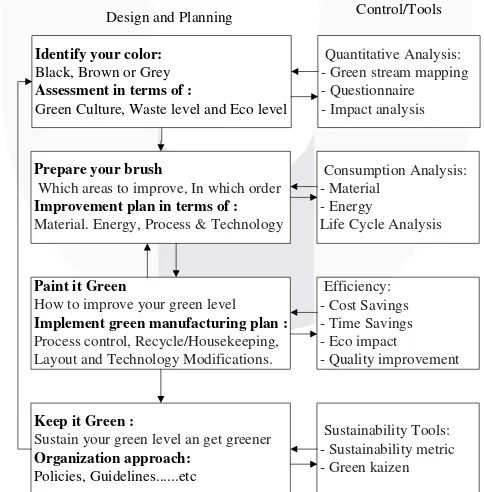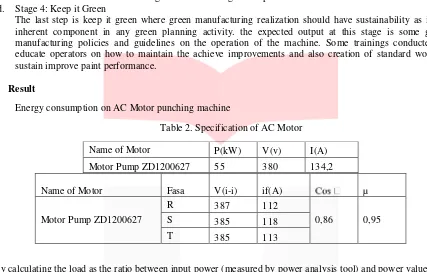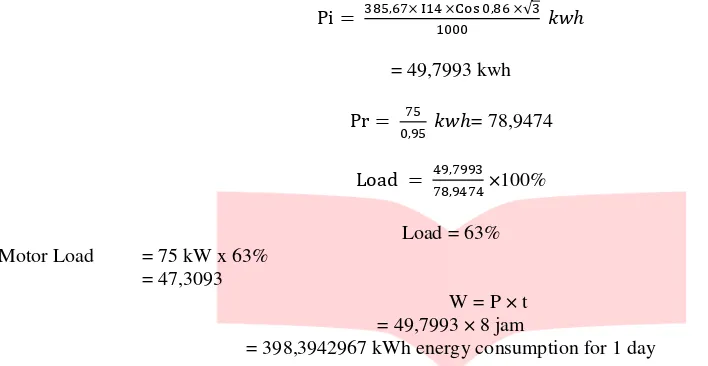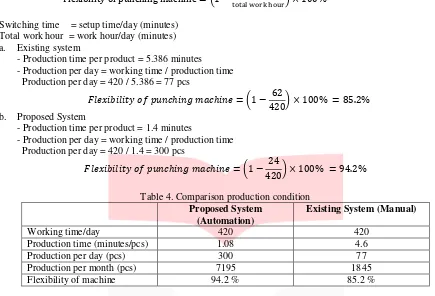FLEXIBILITY IMPROVEMENT ON ENERGY CONSUMPTION OF PUNCHING MACHINE BASED ON GREEN MANUFACTURING METHOD
AT PT BUANA INTAN GEMILANG
Firda Mawaddah1, Haris Rachmat2, Tatang Mulyana3
1,2,3
Industrial Engineering Study Program, Industrial Engineering Faculty, Telkom University
¹[email protected], [email protected], [email protected]
Abstract
These days, Green Manufacturing has established become a new thing for professional engineers and manufacturing workers to be an important part in the business world. Green manufacturing is a method for manufacturing that minimizes waste and pollution. These goals are often achieved through product and process design (Thomas, 2001). Green Manufacturing was created to reflect the new manufacturing paradigm techniques to make something become more eco-efficient by reducing the energy consumption. Jacquard punching machine is a machine that designed to cut a hole in material such as card stock named jacquard card. This card controlled the weaving process in textile industry to enabling produce the patterns of facbic. This machine is still working manually with the flexibility less than 90 percent that led to the longest production time in meeting the request, thus causing the electrical energy released for this machine is also very high. On the basis of these problems required a system to improve the flexibility of the machine in order to be able to reduce energy consumption and make the company become more green environmentally friendly.
From this research generated an automation system which will be applied on a jacquard punchine machine that can increase flexibility machine to be more than 90 percent. This system has saving the electricity consumption of 2092 KWh every making a complete fabric pattern.
Keywords: Green Manufacturing, Automated System, Jacquard Punching Machine, Flexibility
1. Introduction
The continued development of the industrial revolution then the greater energy being used, but instead the availability of energy in the world is actually depleting. Statistics value of energy use in Indonesia 2014 shows that industry sector become the biggest user of electricity energy, followed by household in the second place, business in the third place and another general sector in the last place. Beside that, the use of electrical energy in the industrial sector continue to increase from year to year. PT. Buana Intan Gemilang is one of the textile company in Banjaran, Bandung that produce curtain and prayer mat. PT. Buana Intan Gemilang have several production department, and one of the main part of this company is weaving and preparation department. Punching machine is one of machine that used in preparation department, the machine has function to make the jacquard card of the curtain and prayer mat on the cardboard to use in the weaving machine.
Reducing the energy consumption of electricity will impact to all other manufacturing competitive edges, such flexibility. The concept flexibility in manufacturing has become a key consideration in the design, operation and management of manufacturing system (Sethi & Sethi, 1990). By increasing the flexibility the same as make a better manufacturing system. Automation technique is use as one way to controll and improve the flexibility of jacquard punching machine. Automation is the technology which can perform a series of process or procedure automatically without human assistance. It implemented with execute a list program of instruction which combine by a control system in perform the instruction (Groover, 2001).
The purpose of this research is improving flexibility of jacquard punching machine using automation system in order to be able to reduce energy consumption and make the company to be green manufacturing company.
2. Literature Study
2.1 Jacquard Punching Machine
Figure 1. Jacquard punching machine
In PT. Buana Intan Gemilang the purpose of jacquard punching machine is to make the pattern card (jacquard card) that will be represent the pattern of the facbic (curtain or prayer mat). The things that should be noted in this process is the hole making process and the precision location of the hole it self. The good quality of jacquard card is a card that does not have defect. As increasing demand of textille sector and also supports from the government to develop local textile industries, the company must be able to compete with other local competitor by producing high number of product with high quality, and on the right time. The company usually make the jacquard card with this punching machine in manual way, so its takes an expensive cost for the energy because the machine running in longer time and also low flexibility because the ability to change jacquard is very slow.
2.2 Green Manufacturing Method
In designing the concept of green manufacturing, Deif (2011) implemented a system model as a tool to simplify its application. This model system will be applied in case study at PT. Buana Intan Gemilang to be able to assist in applying the concept of green manufacturing so as to improve the flexibility of the punching machine. Figure IV.4 shows a step by step flow diagram of the process.
Identify your color:
Black, Brown or Grey
Assessment in terms of :
Green Culture, Waste level and Eco level
Prepare your brush
Which areas to improve, In which order
Improvement plan in terms of :
Material. Energy, Process & Technology
Paint it Green
How to improve your green level
Implement green manufacturing plan :
Process control, Recycle/Housekeeping, Layout and Technology Modifications.
Keep it Green :
Sustain your green level an get greener
Organization approach:
Policies, Guidelines...etc
Quantitative Analysis: - Green stream mapping - Questionnaire - Impact analysis
Consumption Analysis: - Material
- Energy
Life Cycle Analysis
Efficiency: - Cost Savings - Time Savings - Eco impact - Quality improvement
Sustainability Tools: - Sustainability metric - Green kaizen
Control/Tools Design and Planning
Figure 2. System model for green manufacturing
a. Stage 1: Color Identification
Base on the result of questionnaire it can be concluded that PT. Buana Intan Gemilang in the brown (medium) position, with the energy of the system have bigger percentage better than the material which means it needs an improvement in part of energy usage. The company has not enough energy-saving in the use of electricity but in terms of waste not too polluting because of all good material of raw materials as well as the rest of the result of production does not damage the environment.
Identify your color
Assessment of the Green level of the manufacturing system
Assessment Score: Brown (medium) Quantitative Assessment
Green Culture
Waste Level
Eco Level
Structured Questionnaire
Figure 3. Model for identification color
b. Stage 2: Improvement Object
In this part the process of planning on the improvement is about what will the company done on the way to make the company more green without affecting the results and production planning. The development process of this improvement will be focused on the energy consumption section of the punching machine up to the implementation of a new technology on the machine that can support the energy saving process it self. Jacquard punching machine is a machine that is designed to cut a hole in some materials such as paper, metal or card. Aspects to be studied further from the results of this improvent application is the flexibility aspect of the punching machine.
Prepare your Brush
Develop improvement plan for areas to improve & in what order without
affecting production
Green Manufacturing Improvement Plan (Energy & Technology) Performance Metrics:
Flexibility
Production Plan
Optimization
Figure 4. Model for green improvement c. Stage 3: Green Implementation
The next process is implementation of all the strategies that have been designed on the punching machine. Automation technology that applied to punching machines will be measured based on changes in production time and energy consumption of punching machines. If the automated punching machine has faster production time and less energy consumption with the amount of production that can meet the targets set by PT.Buana Intan Gemilang, the company has succeeded in increasing the color category from brown to green category.
Image to Excel Wonderware
Intouch Omron Hl
CX-Programmer 9.1
PLC Omron CP1E N30
Paint it Green Smooth executing of the green improvement plan at machine, process and system levels.
Greener Manufacturing (Machine level) Performance Metrics:
Eco impact (Flexibility)
Technology modification
Process control Energy Improvement Plan
Technology Improvement Plan Greener Manufacturing
(System level)
Figure 6. Model for green implementation d. Stage 4: Keep it Green
The last step is keep it green where green manufacturing realization should have sustainability as in an inherent component in any green planning activity. the expected output at this stage is some green manufacturing policies and guidelines on the operation of the machine. Some trainings conducted to educate operators on how to maintain the achieve improvements and also creation of standard work to sustain improve paint performance.
3. Result
Energy consumption on AC Motor punching machine
Table 2. Specification of AC Motor
Name of Motor Fasa V(i-i) if(A) µ
Motor Pump ZD1200627
R 387 112
0,86 0,95
S 385 118
T 385 113
By calculating the load as the ratio between input power (measured by power analysis tool) and power value at 100% loading. For three phase motor, the step is to determine the input power with the following equation:
(1)
Pi = three phase power (kW) V = voltage (V)
I = current (A)
Determine the value of incoming power at full load.
(2)
Whereas :
Pr = incoming power at full load (kW) P = power (kW)
= Efficiency at full load
Then calculate the load in %
×100% (3)
Name of Motor P(kW) V(v) I(A)
Load = Output power expressed in% nominal power value
×100% = 63%
To get the cost incurred by the use of a punching machine can be calculated by the equation below, based on energy data used and the cost of electrical energy / kWh.
Cost Saving = kWh/tahun × Rp/kWh
= 49,7993 kwh
= 78,9474
×100%
Load = 63%
Motor Load = 75 kW x 63%
= 47,3093
W = P × t (4)
= 49,7993 × 8 jam
= 398,3942967 kWh energy consumption for 1 day
Automation systems have been successfully applied to punching machines and have increased the flexibility of the punching machines to match the expected expectations. With automation systems, the production time and setup time of the punching machine can be reduced and the flexibility increases. Reduction of production time and setup time would increase the flexibility so that will reduce the consumption energy of the company.
Table 2. Production existing data
Hari Production Time
(sec)
Setup Time (sec)
Total Time Production
Total Product/day
Wednesday, February 1, 2017 21209 3728 24937 77
Thursday, February 2, 2017 21004 3706 24710 75
Friday, February 3, 2017 21275 3666 24941 75
Saturday, February 4, 2017 21098 3696 24794 79
Monday, February 6, 2017 21494 3694 25188 76
Tuesday, February 7, 2017 20978 3624 24602 77
Wednesday, February 8, 2017 21419 3685 25104 75
Thursday, February 9, 2017 21015 3724 24739 76
Friday, February 10, 2017 21242 3728 24970 78
Saturday, February 11, 2017 20961 3648 24609 75
Monday, February 13, 2017 21464 3716 25180 77
Tuesday, February 14, 2017 21447 3620 25067 80
Wednesday, February 15, 2017 21498 3737 25235 77
Thursday, February 16, 2017 20945 3555 24500 77
Friday, February 17, 2017 21455 3672 25127 78
Saturday, February 18, 2017 21280 3620 24900 79
Monday, February 20, 2017 20997 3726 24723 78
Tuesday, February 21, 2017 21119 3639 24758 75
Wednesday, February 22, 2017 21112 3613 24725 78
Friday, February 24, 2017 21020 3582 24602 79
Saturday, February 25, 2017 21286 3571 24857 75
Monday, February 27, 2017 21217 3678 24895 77
Tuesday, February 28, 2017 21273 3644 24917 76
TOTAL 509219 88022 597241 1845
AVERAGE 21217.45833 3667.583333 24885.04167 76.875
ROUNDUP 21218 3668 24886 77
Table 3. Production proposed data
Hari Production Time
(sec)
Setup Time (sec)
Total Time Production
Total Product/day
Wednesday, February 1, 2017 19542 5589 25131 300
Thursday, February 2, 2017 19490 5549 25039 298
Friday, February 3, 2017 19521 5561 25082 296
Saturday, February 4, 2017 19545 5635 25180 301
Monday, February 6, 2017 19528 5616 25144 298
Tuesday, February 7, 2017 19556 5577 25133 293
Wednesday, February 8, 2017 19477 5613 25090 299
Thursday, February 9, 2017 19475 5630 25105 301
Friday, February 10, 2017 19533 5552 25085 306
Saturday, February 11, 2017 19456 5616 25072 296
Monday, February 13, 2017 19531 5638 25169 300
Tuesday, February 14, 2017 19518 5592 25110 292
Wednesday, February 15, 2017 19417 5548 24965 295
Thursday, February 16, 2017 19412 5622 25034 296
Friday, February 17, 2017 19528 5566 25094 307
Saturday, February 18, 2017 19424 5622 25046 310
Monday, February 20, 2017 19545 5623 25168 299
Tuesday, February 21, 2017 19457 5608 25065 294
Wednesday, February 22, 2017 19463 5630 25093 303
Thursday, February 23, 2017 19541 5617 25158 303
Friday, February 24, 2017 19494 5630 25124 306
Saturday, February 25, 2017 19454 5611 25065 303
Monday, February 27, 2017 19455 5559 25014 301
Tuesday, February 28, 2017 19461 5640 25101 298
TOTAL 467823 134444 602267 7195
AVERAGE 19492.625 5601.833333 25094.45833 299.7916667
ROUNDUP 19493 5602 25095 300
Known :
- Working time per day = 7 hours x 60= 420 seconds - Cost for energy electricity = Rp 1467,8 Rp/kWh - Energy (W) = 348,6 kWh
This formula is used to calculate the flexibility of the machine:
(5)
Switching time = setup time/day (minutes) Total work hour = work hour/day (minutes) a. Existing system
- Production time per product = 5.386 minutes - Production per day = working time / production time Production per day = 420 / 5.386 = 77 pcs
b. Proposed System
- Production time per product = 1.4 minutes
- Production per day = working time / production time Production per day = 420 / 1.4 = 300 pcs
Table 4. Comparison production condition
Proposed System (Automation)
Existing System (Manual)
Working time/day 420 420
Production time (minutes/pcs) 1.08 4.6
Production per day (pcs) 300 77
Production per month (pcs) 7195 1845
Flexibility of machine 94.2 % 85.2 %
Base on that calculation it can be conclude that automation system can increase the flexibility of machine as well the green manufacturing.
Impact from Automation system design successfully implemented and automation system running as expected for increasing the flexibility of the jacquard punching machine. This also results in companies becoming more green manufacturing, where companies can save more energy. The comparison for use energy can see below.
Tabel 5. Comparison of the use of electric energy
Proposed System (Automation) Exixting system (Manual)
Total production (pcs) 600 600
Total day 2 8
Electricity/day (KWh) 348.6 348.6
Total Electricity (KWh) 697.2 2788.8
Cost / KWh Rp 1,467.80 Rp 1,467.80
Cost Rp 1,023,350.16 Rp 4,093,400.64
Base on the calculation costs incurred by companies to produce a number of jacquard cards with punching machines that have been applied green manufacturing methods require a cheaper cost than before the automation. The total cost that can be saved by the company can be seen below:
Base on the calculation biaya yang dikeluarkan perusahaan untuk memproduksi jacquard kartu dengan jumlah yang sama lebih memerlukan biaya yang sedikit dari pada sebelum di otomasi. Total biaya yang dapat dihemat oleh perusahaan dapat dilihat di bawah:
Total savings cost = cost after automation - cost before automation
= Rp 4,093,400.64 – Rp 1,023,350.16
It can be concluded that with applied green manufacturing method using automation system can Saving cost of production and also saving the usage of energy that make the company to be green manufacturing company.
6. Conclusion
The automation system was adopt to the punching machine to make the production time faster so it can significantly increase the flexibility and decrease the energy usage of the punching machine. Based on the analysis result of the system that has been designed and implemented, was conclude as follow:
1. The flexibility of punching machines increased 9 percent from before it was automated.
2. The processing time of jacquard card making is 256 seconds faster than before it was automated. 3. The machine setup time is 38 minutes faster than before it was automated.
4. The energy that can be saved to create a whole pattern of curtain fabric (600 jacquard cards) is 2092 Kwh
So the company's color level increased to green after the adoption of the automation system and the company can reduce the energy consumption significantly.
References
[1] Acharya, P. S., Vadher, D. J., & Acharya, D. G. (2014). A Review on Evaluating Green Manufacturing for Sustainable Development in Foundry Industries. International Journal of Emerging Technology and Advanced Engineering.
[2] Bartodziej, C. J. (2016). The Concept Industry 4.0: An Empirical Analysis of Technologies and Applications in Production Logistics. Springer.
[3] Dornfeld, D. A. (2013). Green Manufacturing Fundamentals and Applications. California : Springer. [4] Fauzan, M. I. (2015). Automation System Design for Stopper Valve Chamfering Process on Bench
Lathe SD-32A Machine at PT. Dharma Precision Parts. Bandung: Telkom University.
[5] Foster, S. T. (2003). Managing quality : an integrative approach . London: Upper Saddle River. [6] Frenky. (2014). Green Manufacturing : A Literature review .
[7] Gilchrist, A. (2016). Industry 4.0 The Industrial Internet of Things. Thailand: Apess.
[8] Groover, M. P. (2001). Automation, Production System and Computer-Integrated Manufacturing. New Jersey: Pearson Education.
[9] I.D.Paul. (2014). A review on Green Manufacturing: It’s important, Methodology and its Application. [10] Liu, Y. (2013). An investigation into minimising total energy consumption and total weighted tardiness
in job shops.
[11] MacDougall, W. (2014). Industrie 4.0. Germany Trade & Invest, 6.
[12] Mineral, K. E. (2014). Statistik Ketenagalistrikan. Jakarta: Direktorat Jendral Ketenagalistrikan. [13] Mori, M. (2011). A study on energy efficiency improvment.
[14] NG, F. M. (2006). Digital Jacquard Textile Design In A Colorless Mode. [15] Ohno, I. (1967). Automatic Card Punching Machine for Jacquard Machine. [16] Petruzella, F. D. (1996). Industrial Electronic. Glencoe: McGraw-Hill.
[17] Raharjo, B. A., Wibawa, U., & Suyono, H. (2013). Studi Analisis Konsumsi dan Penghematan Energi di PT. P.G. Krebet Baru I.
[18] Schlaepfer, D. R., & Koch, M. (2015). Industry 4.0 Challenges and solutions for the digital transformation and use of exponential technologies. Deloitte, 4.
[19] Sethi, A. K., & Sethi, S. P. (1990). Flexibility in Manufacturing: A Survey. Kluwer Academic Publishers.
[20] Webb, J. W. (1999). Programmable Logic Controllers Principles and Applications. America: Prentice Hall Inc.
[21] Yingjie, Z. (2014). Energy efficiency techniques in machining process: a review.





